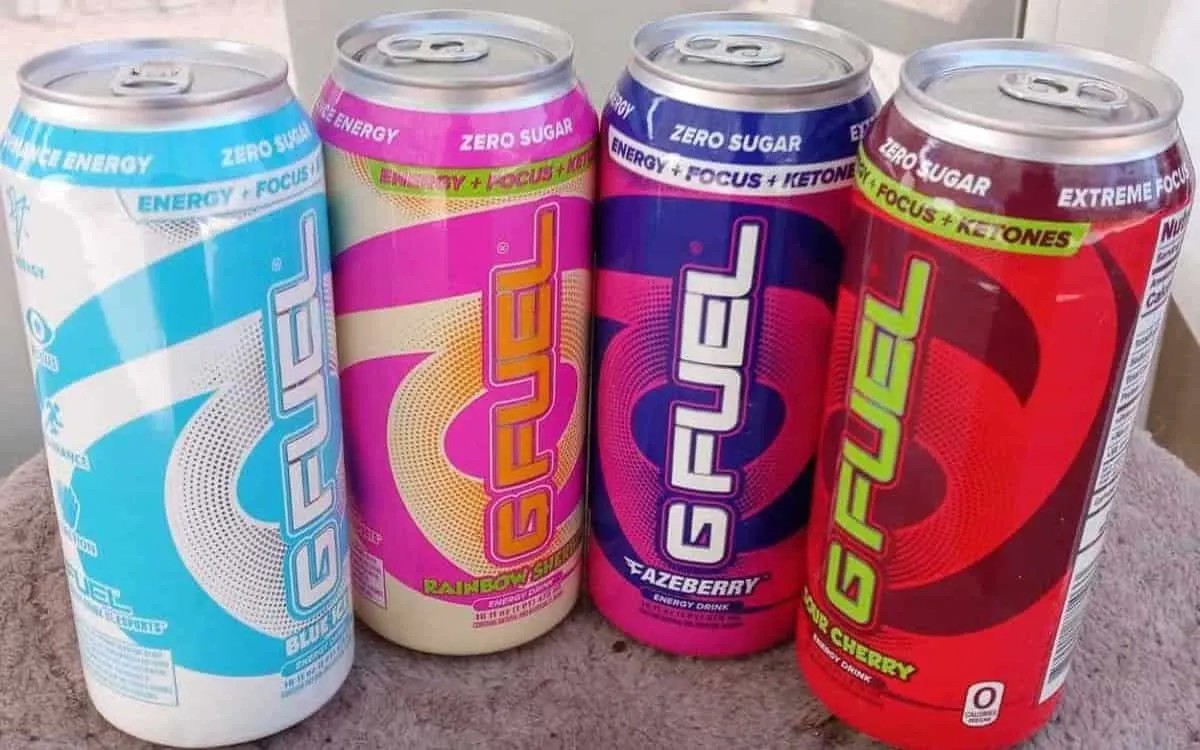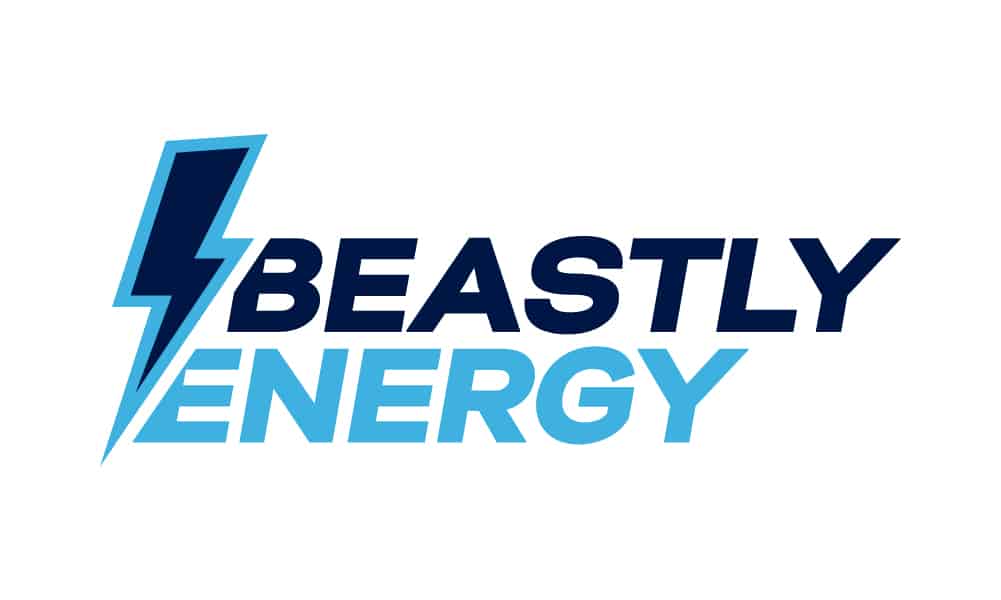G Fuel Powder has a lot to offer. Powdered formulas make it easy to control how much you need to have in a day. A single tub can also last a long time, so you don’t need to buy regularly to enjoy G Fuel.
Still, having to prepare your drink can take a little of your time, especially for those who lead busy lives and move around a lot.
G Fuel Cans can be an easy solution to that problem. But are they good for you?

That’s really up to you. But what you need to know is: G Fuel cans have no calories, no sugar, but loaded with vitamins. It’s also very high in caffeine content to keep you alert and awake during the day.
Read more for my analysis on what all these means and what they could mean for your health.
Contents
G Fuel Can Nutrition Facts
| Nutrient | Amount per Serving (16 fl.oz) |
| Calories | 0 |
| Total Carbohydrates | 0g |
| Sugar | 0g |
| Sodium | 70mg |
| Protein | 0g |
| Potassium | 85mg (2%) |
| Niacin (Vitamin B3) | 4mg (25%) |
| Vitamin B6 | 0.4mg (25%) |
| Vitamin B12 | 0.6mcg (25%) |
| Vitamin C | 45mg (50%) |
| Caffeine | 300mg |
To reiterate, each serving of G Fuel can is worth 16 fl. oz and has no caloric content, zero sugar, and vitamins and minerals, plus, 300g of caffeine.
In nutritional labels, the percentages you see refer to the percentage daily value (also displayed as %DV).
%DV represents how much of your daily need is met by consuming the product. This measurement is often seen attached to labels with respect to vitamins and minerals the body needs.
These are also calculated based on the assumption that you follow a 2000 calorie-per-day diet.
Calories in G Fuel Cans
A can of G Fuel has zero calories.
These calories turn into energy, which you get every time you eat or drink.
Whatever isn’t used by the end of the day turns into fat. Safe to say that this is what your body uses to power you through the days you decide to skip lunch or get less sleep than you need.
Generally, the recommended daily calorie intake is 2000 a day for women and 2500 for men. However, the truth is that how many you really need in a day depends on many factors. The most notable of these are your body size, age, and lifestyle.
So, maintaining a healthy diet is more about balancing the amount you take in with the amount you burn with your daily routine. Avoiding them will only leave you short on the energy your body needs.
Where do calorie-free foods fit into this then?
Simple: they’re myths.
Except for water, no food or drink is entirely calorie-free. There are definitely formulas that keep the product’s calorie content low, but calories will always be there.
This is true even for products like sucralose, which are touted for adding flavor without contributing calories.
“Zero calories” just means the product has less than 5 calories in its formula.
As it turns out, the FDA allows manufacturers to say their product has no calories when it contributes less than five to the consumer’s daily consumption. That means yes, even Splenda has a few calories to add to your diet (3.4 per packet).
By this logic, “negative calorie” foods are also impossible.
Sugar in G Fuel Cans
G Fuel cans have no sugar.
Just like their tub counterparts, they get their flavor from artificial sweeteners instead. To be specific, these are sucralose (Splenda) and Acesulfame Potassium (Ace-K).
Artificial sweeteners are sugar alternatives that add to flavor without contributing calories or at least, without contributing any noteworthy amount.
Like anything else, they contain trace amounts of calories your body absorbs during digestion. Their low-calorie content makes them as popular with people who want to manage their weight as they are with diabetics.
They’re also not without their drawbacks. Studies have linked Ace-K to weight gain and Splenda to imbalances in gut bacteria. The latter can lead to metabolic problems that can leave you vulnerable to other issues later.
Still, both properties need to be studied further before anything can be proved.
As of now, both sucralose and Acesulfame Potassium are considered safe by the FDA.
Caffeine Content in G Fuel Cans

One 16 fl.oz can of G Fuel has 300mg of caffeine.
To put that into perspective, the recommended daily caffeine limit is 400mg. So drinking a G Fuel can is going to take out 75% of what you can safely consume in a day.
And that’s not even considering how common other products that also have caffeine (like chocolate) are.
So if you drink one of these G Fuel cans and don’t watch what else you eat and drink during the day. you’re very likely to get a caffeine overdose.
People going through a caffeine overdose tend to experience the following:
- Dizziness
- Diarrhea
- Insomnia
- Feeling thirstier than usual
- Headache
- Fever
- Being more irritable than usual
And those are just the common symptoms. There are others that warrant calling the hospital for.
The more severe caffeine overdose symptoms are:
- Breathing trouble
- Hallucinations
- Disorientation
- Chest pain
- Palpitations
- Irregular heartbeat
- Involuntary muscle movements
- Convulsions
It’s also worth mentioning that 300mg is more than most people need. The average cup of coffee generally has around 95mg.
So if your routine only involves two cups, then a can of G Fuel might be overkill. This is doubly true for people who are sensitive to caffeine and are more vulnerable to its negative effects than others.
G Fuel and Alcohol

Most people probably wouldn’t think to mix G Fuel with alcohol. Its grainy texture can be off-putting and doesn’t go well with drinks made for casual enjoyment. The can is a different story though.
Put simply, mixing caffeine with alcohol isn’t a good idea. Caffeine is a stimulant, so its rousing effects will mask alcohol’s effects as a depressant (slowing you down).
That means, you’ll be just as drunk as you would be if you didn’t drink the G Fuel. Just less aware of it.
In that scenario, you’ll be a “wide-awake drunk”. You won’t be drowsy, sluggish, or anything that people would normally associate with being inebriated, but still drunk.
You’ll be more likely to overestimate how much more you can drink because you’ll be missing all the signs your body would be giving to say it’s had enough.
Mixing alcohol with caffeine will also make you more vulnerable to the side effects much faster than normal. For caffeine, these are palpitations, irregular heartbeat, trouble falling asleep, and feeling restless.
It’s also worth mentioning that combining a stimulant’s energy boost with alcohol’s lower inhibitions can result in you being more reckless than you would be (drunk or otherwise).
Sodium in G Fuel Cans
A G Fuel can has 70mg of sodium. That’s 3% of what you need everyday.
Sodium is both an electrolyte and mineral that maintains the hydration in your cells. It’s also important for making sure your muscles and nerves remain functional.
Within the body, sodium is found in the blood and lymph fluid. It’s also controlled by a hormone called aldosterone, which tells the kidneys when to retain sodium instead of letting it out through urine.
So yes, your body does need sodium to be healthy. Because of this, it’s recommended that you take less than 2300mg of sodium a day. That’s less than a teaspoon!
As a rule, any sodium lower than 10% of your daily value is considered low while anything above 40% is high in sodium.
Why not more? Sodium is a lot more common than you think, so it’s easy to unintentionally consume way more than you should. It’s common in prepared food since it’s a good preservative.
It’s also seen in foods like:
- Breads
- Rolls
- Pizzas
- Cheese
- Dairy products
- Chicken
- Snack foods (e.g Cheetos and Doritos)
So all in all, G Fuel cans are okay in terms of sodium content. However, you might want to watch what else you eat if you don’t want to end up with too much in your system.
Vitamins in G Fuel Cans

G Fuel cans have Vitamin B3, B6, and B12. They also have Vitamin C.
Vitamin B3, B6, and B12 are similar in that they all aid metabolism and give you energy boosts when digested. They’re commonly found in meat, fish, and vegetables.
Vitamin C helps your body absorb iron, which your body needs for growth and development. Like the B-vitamins, it’s not naturally produced by the body, so most people need to incorporate sources into their diets. Foods that have Vitamin C include oranges, strawberries, and broccoli.
The nutrition label also lists the daily values you get from drinking G Fuel as 25% (B3, B6, B12) and 50% (Vitamin C).
Although it’s true that there are recommended amounts for vitamins just like with any other substance in your diet, it’s highly unlikely that you’ll have to worry about an overdose just from food and drinks alone.
Vitamin overdose is more something that people who take the synthesized medication version need to worry about. Don’t worry.
The B-vitamins and Vitamin C are all water soluble. So whatever excess you have will get released in your urine.
Conclusion
The G Fuel Cans have very little calories, zero sugar, 300mg of caffeine, and 70mg of sodium. They’re also loaded with vitamins that are believed to boost your metabolism.
There’s not much to say about any of these except the caffeine. 300mg is twice what the tubs have and makes G Fuel cans one of the more caffeinated energy drinks on the market.
That’s not necessarily a bad thing since that makes it good for its intended purpose: giving you the surge of energy you need to get through the day.
However, it does mean you need to be mindful of what else you consume on the days you have a G Fuel can. Otherwise, you might find yourself either in the emergency room because of a caffeine overdose or lying restless in bed all because of the excess caffeine.
On a lighter note, G Fuel is known for its wide assortment of flavors. And the can version is no different and even has similarly colorful and creative-sounding names the classic tubs have.
What are the flavors? Do they taste as good as they look and sound?
If you’re curious about that, here’s a video of a YouTuber trying every flavor he has and ranking them.
While G Fuel promises to give you the energy you need in a day, it should be taken in moderation like any other food or drink. G Fuel has the basic nutrients you need for your workouts and other heavy activities, but make sure that you know when and how much you should drink per day.
Other Articles:
To learn more about what the G Fuel brand is and its benefits to the body, here are some articles to help you out.
